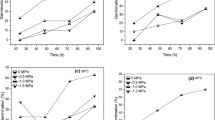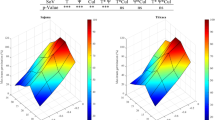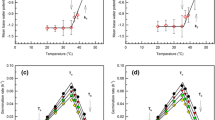Abstract
Cantaloupe (Cucumis melo L.) and radish (Raphanus sativus L.) are considered as important vegetables with potential for national and international markets due to their sugars, vitamins and minerals. This study arranged, therefore, to simultaneously investigate the effect of temperature (T) and water potential (ψ) on seed germination (SG) of these plants using two hydrothermal time (HTT) models and to determine cardinal Ts and base water potential (ψb(50)) for both species. The results indicated that SG of both species was more affected by ψ than T (p ≤ 0.001). At Ts below an optimum temperature (To) the ψb(50) was constant (− 0.582 and − 0.760 MPa for radish and cantaloupe, respectively) and then increased linearly by 0.0481 and 0.0446 MPa °C−1 as T increased above To (as thermoinhibition) until 0 MPa at the ceiling temperature (Tc), respectively. As the first report, however, we observed that the T at which ψb(50) begins to change was the same here (that is, Td = To), when determined by either model for both species. This result suggests that the assumption in Rowse and Finch-Savage’s model (Td is often less and or very close to To) may be invalid in some cases. For both species, the base temperature (Tb) and To were not affected by ψ and were constant while there was an exception only for Tc for which the value declined with decreasing ψs (more negative). In general, the estimated Tb, To and Tc were 9.64, 21.3 and 33.0 °C for radish and 11.8, 28.3 and 45.7 °C for cantaloupe in the control condition (ψ = 0 MPa), respectively. The HTT models used here and their parameters, each with strengths and weaknesses, can be used as a predictive tool in both cantaloupe and radish SG simulation models. However, at first, we need to select an appropriate HTT model based on SG behavior of plant species and then use the best model for quantifying the response of SG across Ts and ψs.





Similar content being viewed by others
References
Abdellaoui R, Boughalleb F, Zayoud D, Neffati M, Bakhshandeh E (2019) Quantification of Retama raetam seed germination response to temperature and water potential using hydrothermal time concept. Environ Exp Bot 157:211–216
Alvarado V, Bradford K (2002) A hydrothermal time model explains the cardinal temperatures for seed germination. Plant Cell Environ 25:1061–1069
Atashi S, Bakhshandeh E, Zeinali Z, Yassari E, Teixeira da Silva JA (2014) Modeling seed germination in Melisa officinalis L. in response to temperature and water potential. Acta Physiol Planta 36:605–611
Atashi S, Bakhshandeh E, Mehdipour M, Jamali M, Teixeira da Silva JA (2015) Application of a hydrothermal time seed germination model using the Weibull distribution to describe base water potential in zucchini (Cucurbita pepo L.). J Plant Growth Regul 34:150–157
Bakhshandeh E, Gholamhossieni M (2018) Quantification of soybean seed germination response to seed deterioration under PEG-induced water stress using hydrotime concept. Acta Physiol Planta 40:126
Bakhshandeh E, Atashi S, Hafez-Nia M, Pirdashti H (2013) Quantification of the response of germination rate to temperature in sesame (Sesamum indicum). Seed Sci Technol 41:469–473
Bakhshandeh E, Atashi S, Hafeznia M, Pirdashti H, Teixeira da Silva JA (2015) Hydrothermal time analysis of watermelon (Citrullus vulgaris cv.‘Crimson sweet’) seed germination. Acta Physiol Planta 37:1738
Bakhshandeh E, Jamali M, Afshoon E, Gholamhossieni M (2017) Using hydrothermal time concept to describe sesame (Sesamum indicum L.) seed germination response to temperature and water potential. Acta Physiol Planta 39:250
Baskin CC, Baskin JM (2014) Seeds: ecology, biogeography, and, evolution of dormancy and germination. Academic Press, San Diego, p 1600
Bewley JD, Bradford K, Hilhorst H, Nonogaki H (2013) Seeds: physiology of development, germination and dormancy, 3rd edn. Springer, New York
Bouzo C, Küchen M (2012) Effect of temperature on melon development rate. Agron Res 10:283–294
Bradford KJ (2002) Applications of hydrothermal time to quantifying and modeling seed germination and dormancy. Weed Sci 50:248–260
Bradford KJ, Still DW (2004) Applications of hydrotime analysis in seed testing. Seed Technol 26:75–85
Casenave E, Toselli M (2007) Hydropriming as a pre-treatment for cotton germination under thermal and water stress conditions. Seed Sci Technol 35:88–98
Casenave E, Toselli M (2010) Germination of melon seeds under water and heat stress: hydropriming and the hydrotime model. Seed Sci Technol 38:409–420
Cheng Z, Bradford KJ (1999) Hydrothermal time analysis of tomato seed germination responses to priming treatments. J Exp Bot 50:89–99
Copeland LO, McDonald MF (2012) Principles of seed science and technology, 4th edn. Vol 467, Springer, New York
Dahal P, Bradford KJ (1990) Effects of priming and endosperm integrity on seed germination rates of tomato genotypes II. Germination at reduced water potential. J Exp Bot 41:1441–1453
Dahal P, Bradford KJ (1994) Hydrothermal time analysis of tomato seed germination at suboptimal temperature and reduced water potential. Seed Sci Res 4:71–80
Gummerson R (1986) The effect of constant temperatures and osmotic potentials on the germination of sugar beet. J Exp Bot 37:729–741
Gunawardena M, De Silva C (2016) Effects of global warming simulated temperature and water stress on fruit quality of tomato (Lycopersicum esculantum) Var. Rajitha. OUSL J 11:93–112
Günay A (2005) Sebze yetiştiriciliği. Cilt-II, Meta Basımevi, İzmir
Gurvich D, Pérez-Sánchez R, Bauk K, Jurado E, Ferrero M, Funes G, Flores J (2017) Combined effect of water potential and temperature on seed germination and seedling development of cacti from a mesic Argentine ecosystem. Flora 227:18–24
Hardegree SP, Walters CT, Boehm AR, Olsoy PJ, Clark PE, Pierson FB (2015) Hydrothermal germination models: comparison of two data-fitting approaches with probit optimization. Crop Sci 55:2276–2290
Kebreab E, Murdoch A (1999) Modelling the effects of water stress and temperature on germination rate of Orobanche aegyptiaca seeds. J Exp Bot 50:655–664
Kurtar ES (2010) Modelling the effect of temperature on seed germination in some cucurbits. African J Biotechnol 9:1343–1353
Larsen SU, Bailly C, Côme D, Corbineau F (2004) Use of the hydrothermal time model to analyse interacting effects of water and temperature on germination of three grass species. Seed Sci Res 14:35–50
Lindgren DT, Browning SJ (2011) Vegetable garden seed storage and germination requirements. University of Nebraska-Lincoln Extension, Institute of Agriculture and Natural Resources; Index Lawn & Garden Vegetables issued June 2011
Ludewig K, Zelle B, Eckstein RL, Mosner E, Otte A, Donath TW (2014) Differential effects of reduced water potential on the germination of floodplain grassland species indicative of wet and dry habitats. Seed Sci Res 24:49–61
Mesgaran MB, Onofri A, Mashhadi HR, Cousens RD (2017) Water availability shifts the optimal temperatures for seed germination: a modelling approach. Ecol Model 351:87–95
Michel BE, Radcliffe D (1995) A computer program relating solute potential to solution composition for five solutes. Agron J 87:126–130
Milani E, Seyed M, Razavi A, Koocheki A, Nikzadeh V, Vahedi N, MoeinFard M, GholamhosseinPour A (2007) Moisture dependent physical properties of cucurbit seeds. Int Agrophys 21:157
Rowse H, Finch-Savage W (2003) Hydrothermal threshold models can describe the germination response of carrot (Daucus carota) and onion (Allium cepa) seed populations across both sub-and supra-optimal temperatures. New Phytol 158:101–108
Salk A, Arın L, Deveci M, Polat S (2008) Special vegetable growing. Turkish, Tekirdag, p 488
SAS Institute Inc (2013) SAS/STAT user’s guide. SAS Institute Inc., Cary
Singh D (1991) Effect of temperature on seed germinability of Momordica charantia L. cultivars. N Agric 2:23–26
Swann AL, Hoffman FM, Koven CD, Randerson JT (2016) Plant responses to increasing CO2 reduce estimates of climate impacts on drought severity. Proc Natl Acad Sci 113:10019–10024
Wang R (2005) Modeling seed germination and seedling emeregence in winterfat (Krascheninnikovia lanata (Pursh) A.D.J. Meeuse & Smit): physiological mechanisms and ecoligical relevance. Ph.D. thesis, University of Saskatchewan, p 190
Wang R, Bai Y, Tanino K (2004) Effect of seed size and sub-zero imbibition-temperature on the thermal time model of winterfat (Eurotia lanata (Pursh) Moq.). Environ Exp Bot 51:183–197
Watt MS, Bloomberg M (2012) Key features of the seed germination response to high temperatures. New Phytol 196:332–336
Watt M, Bloomberg M, Finch-Savage W (2011) Development of a hydrothermal time model that accurately characterises how thermoinhibition regulates seed germination. Plant Cell Environ 34:870–876
Xu H, Su W, Zhang D, Sun L, Wang H, Xue F, Zhai S, Zou Z, Wu R (2017) Influence of environmental factors on Cucumis melo L. var. agrestis Naud. Seed germination and seedling emergence. PLoS ONE 12:e0178638
Acknowledgements
This research is supported by the Genetics and Agricultural Biotechnology Institute of Tabarestan (GABIT) and Sari Agricultural Sciences and Natural Resources University (SANRU) research Grant (D.2399.96.31). The authors also gratefully acknowledge use of the services and facilities of the GABIT during this research.
Author information
Authors and Affiliations
Corresponding author
Ethics declarations
Conflict of interest
The authors have declared no conflict of interest.
Additional information
Publisher’s Note
Springer Nature remains neutral with regard to jurisdictional claims in published maps and institutional affiliations.
Rights and permissions
About this article
Cite this article
Bakhshandeh, E., Gholamhossieni, M. Modelling the Effects of Water Stress and Temperature on Seed Germination of Radish and Cantaloupe. J Plant Growth Regul 38, 1402–1411 (2019). https://doi.org/10.1007/s00344-019-09942-9
Received:
Accepted:
Published:
Issue Date:
DOI: https://doi.org/10.1007/s00344-019-09942-9




